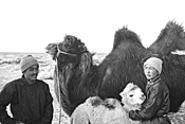Luckily, the filmmakers got exactly the kind of pivotal event they were hoping for -- an unexpected act of nature that served to dramatize the dynamics of the family, their traditional beliefs, and their crucial relationships with the animals that sustain them. The result, beautifully and respectfully filmed, is a vivid anthropological document suffused with plenty of emotion and a touch of tribal magic. Anyone who admired the one-of-a-kind Inuit survival film The Fast Runner (Atanarjuat) in 2002 is likely to embrace Weeping Camel too. Just don't expect any flaming multiple-car pileups, or Brad Pitt and 10,000 archers laying siege to a papiér-mâché set the size of Burbank.
The dramatically useful accident that befell Davaa and Falorni happened in the spring of 2002. According to Mongol legend, if a mother camel rejects her newborn calf, the herding family must call in a musician to perform a kind of seduction ritual. The musician plays. The mother camel becomes enchanted. Before you know it, she sees the error of her ways and begins nursing the calf. Not only that, she weeps -- out of regret, out of sorrow, and for the joy of her newfound bonding with baby. And that's exactly what we see here in the end -- a huge, double-humped brown camel with grotesquely matted fur and a nose like Ernest Borgnine's, crying huge tears to the mysterious strains of what looks like a boxy, two-stringed cello. There is no evidence to suggest that she does so on cue. The four-legged actress on camera here, whose name is "Ingen Temee," has had no formal training, and it's unlikely that an emotional performance here will earn her a percentage of the gross from her next movie.
Before that culminating scene, however, we get a good, full-blooded portrait of Mongol desert life. Family members till the soil and sharpen their scissors, weave their garments, tend the goats, and bathe the children. Along with the full array of native crafts, we also get the occasional aphorism. Taking his first glimpse of a newborn camel, one elder declares: "May your humps grow straight and your hooves grow strong." We also learn, in time, that the camel wanted to be one of the animals in the eastern zodiac, but didn't make the cut. As consolation, God gave it "the tail of the snake, the ears of the pig, and the eyes of the cow." Not to mention Jay Leno's chin.
Co-director Falorni (who doubles as cinematographer) and camera assistant Sebastian Grundt give us beautiful views of southern Mongolia's snowcapped Altai Mountains and the surprisingly ornate interiors of the round native tents, called yurts. They film herds of sheep, goats, and camels with the kind of sensitivity you'd expect from filmmakers intent on showing the eternal bond between human beings and animals. When we see the abandoned little camel -- a rare white one -- whimpering for its mother's attention, there's an arresting purity in the image. When the Mongol family's two young grandsons are sent off on camelback to a distant village to summon the musician, their sense of adventure is equaled by their depth of purpose. This also gives the filmmakers an opportunity to comment gently on the incursions of modern life (as if the presence of their own cameras and microphones were not enough): At a general store, the smaller boy, Ugna, is much impressed at seeing his first TV set; once he gets a glimpse of video games, we wonder how long it will be until the old ways are gone for good. The mother camel is enthralled by warbling strings; Ugna is snowed by GameBoy.
The Story of the Weeping Camel is not for everyone, but this sincere, nicely wrought vision of familial devotion, nature in crisis, and tradition at risk offers all sorts of attractions -- not least, the idea that a creature so stubborn, so ungainly, so oddly constructed as a camel might actually have a soul. Anyway, let's hope so.










